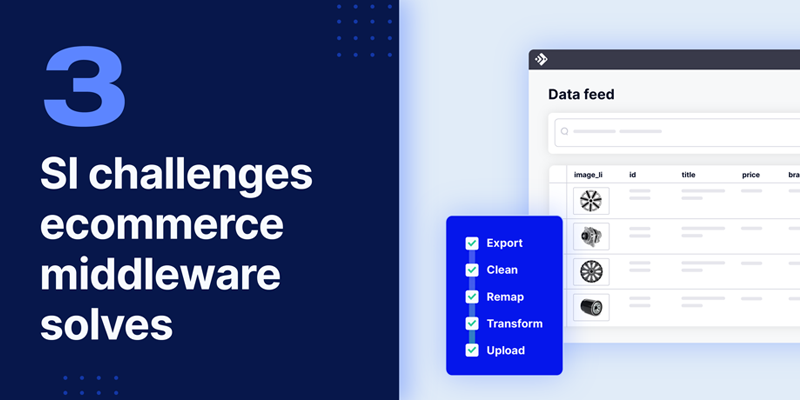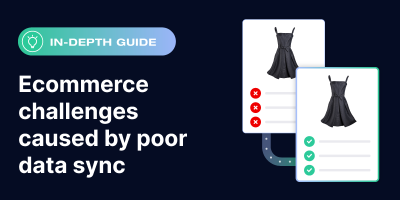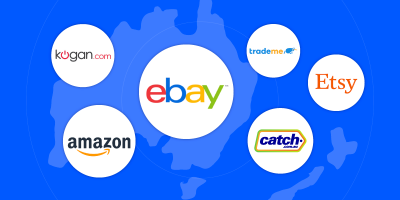The evolution of ecommerce has continuously made it easier for consumers to go from product search to checkout to delivery. This is in large part thanks to the work of system integrators (SIs), who manage an array of connected systems, platforms, and channels. With their expertise, a complex and layered backend produces the seamless experience that brands provide to customers.
To ensure data is moved, synchronized, protected, and formatted correctly, SIs must overcome a number of barriers. Keep reading to learn about the challenges they face and how they can make multichannel ecommerce scalable for their organizations.
1. Integrating with new channels is a huge investment
A key objective for any brand is to increase revenue. In ecommerce, this can mean listing products on more advertising channels like Google Shopping, Meta, and Pinterest, and making sales on marketplaces like Amazon, Walmart, TikTok, eBay, and Target Plus.
Rather than manually uploading product data files to each of these channels, it’s more scalable to automate the process by building an integration between the product data source and the sales channel. Common data sources include websites, ecommerce platforms, or warehouse systems.
The challenge is that each sales channel has its own APIs and data schema requirements, so building new integrations is costly and time-consuming. System integrators must dig through the documentation to learn about available endpoints, as well as rate limits and accepted data formats.
Once an integration is built, SIs expect to perform ongoing maintenance as channels update their APIs and requirements over time. This workload grows exponentially as a brand expands to additional channels.
Even if a brand invests in building an integration to a new channel, there’s no guarantee that the brand will find success, so there’s a significant amount of risk in devoting major in-house resources to the project.
How middleware improves the process of channel integration
For brands that want to take advantage of new opportunities and go to market quickly, using a middleware feed management platform with pre-built integrations is ideal. This way, an SI only needs to connect to a single platform to access hundreds of channels, and the platform owns the ongoing maintenance for every channel’s API updates.
It’s easier to be strategic and agile without the added pressure of months of development influencing decisions. Brands avoid the sunk-cost fallacy of devoting more and more in-house resources to a channel that’s not working for them; by integrating with a middleware platform, they can try out another channel quickly.
2. Mapping, formatting, and optimizing data is not intuitive
Most brands use an ecommerce platform to manage their website data, but these aren’t built to manage data between channels, and it’s critical to format your listings for each shopping destination.
Mapping product attributes directly from the source data to the outgoing channel is rarely straightforward, because each channel only accepts certain values. Valid value requirements can be as specific as the naming of colors, the abbreviation or spelling of sizes (XL vs. extra large), and the character counts of titles or descriptions. In most cases, it’s necessary to transform the data before products can be listed on new channels.
Once the initial catalog export is done, SIs still have to be prepared to make updates. It’s not uncommon for a marketing team to request changes to the product listings or the addition of new fields, such as bullet points, additional images, and custom labels for campaign management.
SIs often have to troubleshoot issues or make changes to source data, depending on the platform being used. It’s good practice to limit user access to critical personnel only, especially when the source data is exposed.
How middleware improves the process of data optimization and migration
Remember that integrated middleware technology we mentioned before? Well, if you find a good one, it’s kind of like Excel on steroids. Once your product data is connected to the platform, it’s possible to endlessly transform and map the content within the platform to prepare files in any format you need.
In ecommerce, using a middleware platform to make catalog updates allows you to optimize your data for individual campaigns and channels without affecting your source data. This is important because product listings optimized for a marketplace like Amazon won’t perform the same on a social commerce destination like Facebook. For example, you might want to employ shorter product titles for social audiences, or feature lifestyle images instead of product photography.
Once your data is imported to a feed management platform, you can give read or write access to the accounts of your choosing. A powerful platform like Feedonomics uses simple language for data transformation, so even non-experts can make quick changes. The platform shows users the before and after states of any transformations, so they can easily validate their adjustments.
Take control of your data with help from our full-service feed specialists
3. Maintaining data integrity is complex across multiple channels
As more channels are layered into your ecommerce mix, it becomes easier to miss small problems in your data. The result is a snowball effect that impacts your listings downstream.
For example, if you have a catalog with a large volume of SKUs, updating your listings on a channel can be slow. A long processing time can result in a timeout on the channel’s side. If you’re not monitoring the upload, you might not realize that it never went through. Now customers are looking at outdated inventory, and the end result is a series of orders you need to cancel.
Any number of data anomalies can affect your listings. Establishing data governance protocols to minimize the number of errors affecting external channels is simple with the right platform.
How to protect the integrity of your data
Feedonomics is equipped with data governance features that monitor the quality of imported data, transformed data, and exported data. You can set up alerts that trigger when a certain percentage of your products are out of stock or prices are missing, and receive email notifications to help you investigate the problem at the source.
You can also choose to exclude groups of products from your exports, or allocate and reserve inventory on different channels to avoid overselling issues.
With a powerful and versatile feed management platform supporting your business, you can solve common ecommerce challenges in a scalable manner.

With its leading data feed management platform, Feedonomics helps brands, retailers, and agencies optimize and list products on hundreds of shopping destinations around the world. Learn more about our full-service solutions for advertising channels and marketplaces.



